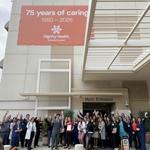Last spring, I wrote about the difficult balancing act California faces as it expands universal transitional kindergarten while trying not to further destabilize the already fragile network of small, often home-based day cares.
San Mateo County’s Child Care Partnership Council, a local body under shared leadership of the San Mateo County Board of Supervisors and the San Mateo County superintendent of schools, has recently completed an updated child care needs assessment that offers a timely picture of what’s actually happening on the ground.
Across San Mateo County, access to preschool aged care has grown as expected due to the UTK rollout, expanded state preschool programs, and increased center-based capacity. Looking at cohort data reinforces what we all believed would happen — preschool capacity saw the largest gains where supply now exceeds demand by more than 6,000 seats, in large part due to 4-year-olds shifting into TK classrooms. As well, the gap in after-school program slots improved to a deficit of 7,500 spaces and serving 74% of need (an increase of ~3,000 slots since 2022). For working parents countywide, challenges here continue to be a hot topic.
When it comes to supply for ages birth-2, only 69% of demand is being met leaving more than 1,400 little ones countywide without access to licensed care. At the same time, there is a notable decline in licensed family child care homes. Small, often home-based operations have decreased by 24% — or 153 businesses — since 2017, and the industry is still testing viable business models without older preschoolers. This is an essential but increasingly endangered part of the ecosystem. With family child care homes representing 40% of the county’s infant care, this is an area that demands attention.
In many cases, families are turning to informal care networks and relying on friends, relatives or nannies outside of the licensed system. The report estimates that nearly 42% of children under the age of 5 are being cared for in these arrangements. While this of course works for many families, there is a broad range of “ready for kindergarten” that reflects the incredible variation in how structured (or unstructured) those early care experiences can be.
Perhaps the most sobering data point is the gap in subsidized care coverage. For infants and toddlers who are eligible for subsidized child care, only 12% are being served — leaving more than 8,000 children without access to structured early learning environments even though they qualify for public support. While an improvement from 96% of infants not being served from this cohort, the number remains large and warrants highlighting. The culprits to this gap are limited funding (and existing funding that is potentially at risk of being cut), an insufficient number of slots available, and a reimbursement system that hasn’t always matched the true cost of care.
This moment presents as both challenge and opportunity: How do we grow the full range of options across the child care ecosystem to meet the diverse needs of working families?
Recommended for you
Despite the myriad of complexities, there are certainly signs of innovation and resilience. Some providers have begun to shift their operating models to include after-school care for TK students since public schools do not offer “full work day” coverage. Others have also shifted successfully toward focusing on infants and toddlers where the need is most acute. As well, there is ongoing discussion of other successfully implemented blended models and the county announced late last year the kickoff of a strategic planning process called the Child Care Blueprint.
Build Up San Mateo County, a nonprofit specifically focused on supporting the expansion and improvement of high-quality child care facilities countywide, has distributed more than $1 million in funding to family child care homes since 2018 for renovation and expansion to support meeting demand.
“High-quality, sustainable facilities are critical to supporting working families, enabling economic growth, and making housing developments truly family friendly,” Executive Director Christine Padilla said. “Child care must be treated as core infrastructure — just like schools, roads and housing.”
Yes, there has been meaningful progress in key areas of focus. But there are also critical parts of the system that demand our collective attention. This is where you come in — the Child Care Partnership Council will soon be recruiting new members. If you care about this issue, this is a place where your voice can help shape local policy. Because of shared oversight, the application process differs slightly from a typical city or county commission. Instructions will be on the council’s website in the coming weeks at https://tinyurl.com/SMCCPC — next meeting is 6:30 p.m. June 23, at the San Mateo County Office of Education. All are welcome.
Another year has gone by. Looking ahead, the mindset must be this: Child care is not simply a service. It is urgent and essential infrastructure that makes full economic participation possible.
Annie Tsai is chief operating officer at Interact (tryinteract.com), early stage investor and advisor with The House Fund (thehouse.fund), and a member of the San Mateo County Housing and Community Development Committee. Find Annie on Twitter @meannie.































(2) comments
Annie - it is simple. If you can't find a way to take care of your kids, don't have them. Since when is your neighborhood responsible for decisions that you make?
yes. it is her choice.
Welcome to the discussion.
Log In
Keep the discussion civilized. Absolutely NO personal attacks or insults directed toward writers, nor others who make comments.
Keep it clean. Please avoid obscene, vulgar, lewd, racist or sexually-oriented language.
Don't threaten. Threats of harming another person will not be tolerated.
Be truthful. Don't knowingly lie about anyone or anything.
Be proactive. Use the 'Report' link on each comment to let us know of abusive posts.
PLEASE TURN OFF YOUR CAPS LOCK.
Anyone violating these rules will be issued a warning. After the warning, comment privileges can be revoked.